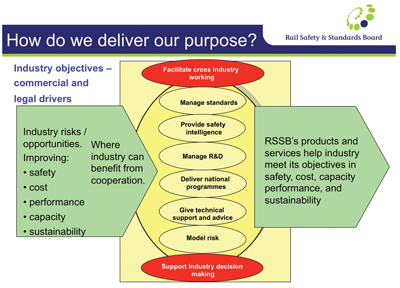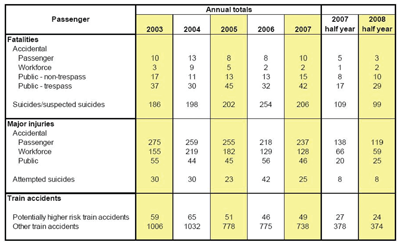Smarter safety means smarter business
Posted: 3 December 2008 | | No comments yet
How RSSB’s knowledge, analysis, technical expertise and powerful information and risk management tools deliver a unique mix to the industry across a whole range of subject areas.
How RSSB’s knowledge, analysis, technical expertise and powerful information and risk management tools deliver a unique mix to the industry across a whole range of subject areas.
In the multi-stakeholder GB industry, RSSB builds industry-wide consensus and produces a wide range of products and services to help the industry resolve difficult issues. RSSB’s knowledge, analysis, technical expertise and powerful information and risk management tools deliver a unique mix to the industry across a whole range of subject areas. The critical success factor for the railway is meeting its customers’ needs at reasonable cost – for both passengers and freight.
In Britain, following restructuring and privatisation between 1994 and 1997, the mainline railway industry is composed of many separate organisations, which combine to deliver passenger services and freight transport. These include infrastructure managers, train and freight operating companies, rolling stock companies and suppliers. The government has several roles and there are also independent bodies with regulatory or investigatory roles.
Whilst these organisations are separate from each other, they all need to work closely together to create a safe and efficient railway. Much of the necessary cooperation is delivered by contract or by direct partnership.
However, the industry also needs to work together in a more proactive way to achieve increases in capacity, improvements in safety and performance, and reductions in cost. The industry needs to take collective decisions about many technical, economic, and safety issues, taking account of the interactions and interfaces between organisations. Where such cooperation is needed, no single organisation can decide how it should be achieved. It is necessary for different organisations to work together and make decisions based on industry consensus.
This is the purpose of RSSB – to support industry cooperation, provide expertise and deliver knowledge, to help the industry deliver a better railway. We’re independent, not-for-profit, owned and funded by the major industry stakeholders themselves but independent in decision making for any particular part of the industry. This direct connection means we can provide a high level of accessibility and value-for-money to the industry.
During the last five years, the number of people and goods moved by rail has increased dramatically, creating the fastest growing major railway in Europe, while safety performance has continued to improve. Over the last four years, there has been only one accident in which a (single) life was lost.
The industry itself can take credit for growth and safety improvements, as its day-to-day attention to detail and service is core to these achievements, but RSSB has supported and facilitated improvements across a whole range of our services – through research, standards, safety plans, analysis of risk and much more. Figure 1 shows how the rail industry exploits RSSB’s ‘toolkit’ to deliver a safe and sustainable railway.
Research and development
Research and development (R&D) forms an important contribution to the product-range RSSB delivers to the industry. The industry’s rail industry research programme is managed by RSSB, funded by the Department for Transport, and focuses on industry-wide research that no individual company or sector of the industry can address on its own.
The programme provides a capability to develop new knowledge to support industry action and decision making across a range of issues. Research is generally proposed by RSSB members, and it can be undertaken in any area that supports the improved performance of the GB railway system.
In taking on board the formal involvement of core railway companies as well as opt-in membership of suppliers and manufacturers, RSSB is well placed to manage this research. The programme covers ‘systems’ issues across the railway, engineering interfaces within the railway, and interfaces with other parts of the community. The programme is also instrumental in supporting the development of a future vision for the railways and assessing how that vision can best be delivered.
In a boost to the industry’s overall research capacity, DfT has recently supported an addition to our capability by announcing £15 million of additional funding over five and a half years, for RSSB to develop and deliver a new strategic research programme. The Rail Technical Strategy, published by the UK Government in 2007, identifies long term challenges which require step changes in many areas, and the new strategic research programme is designed to support its delivery.
In facilitating a wide range of cross-industry groups and cooperation at various levels, combined with significant in-house technical expertise, RSSB is an efficient means of delivering the programme under one roof, saving the industry money.
A source of safety intelligence
An important component of RSSB’s services is the management and provision of the Safety Management Information System (SMIS). The national web-based IT system is used by the rail industry to record all safety related events that occur on Network Rail-managed infrastructure. This industry’s own standard mandates its use so that all data is accessible for the industry to use the information to analyse risk, predict trends and focus activities in key risk areas.
RSSB publishes regular reports collating and summarising the statistics reflecting key risks. These are collectively published in RSSB’s Annual Safety Performance Report. RSSB also supports the industry in its planning for safety improvement and publishes a compilation of all companies safety plans in the industry’s Strategic Safety Plan.
The most recent report for the first half of 2008 shows safety performance was in line with that seen during the same period in 2007. Improvements were reported in workforce major injuries and passenger boarding and alighting injuries. A distinct message the statistics provide is that where areas of risk are in the industry’s direct control, those risks can be managed and minimised with the support of technology and an appreciation for the human factors involved. At level crossings, higher number of pedestrian fatalities and collisions between trains and road vehicles – both of which were above average for the half year to June 2008 – point to this being a key risk area where the primary risk source is outside the direct control of the industry, i.e. the misuse of crossings by the road user. In recognition of this, Network Rail has launched a new campaign through national media (Don’t Run the Risk) and the re-launched cross-industry Road-Rail Interface Safety Group, which RSSB facilitates, is sponsoring research into level crossings from the public behaviour perspective.
However, the bigger picture is one of ever-improving safety, and this means the rail industry can focus on improving business efficiency and driving out unnecessary costs as drivers to achieving the same high levels of safety. The statistics also provide signposts for the cross-industry groups facilitated by RSSB to take decisions or commission research.
Taking safe decisions
Almost every policy, investment or operational decision taken by the GB railway industry has an impact on safety. It is therefore vital that the consideration of safety is embedded effectively into the decision-taking process. To support this, Taking safe decisions – was published by RSSB in June.
Taking safe decisions is the product of an extensive programme of research, analysis and consultation. It describes the industry consensus view of how decisions should be taken that properly protect the safety of rail industry staff, passengers and others, satisfy the law and respect the interests of stakeholders, whilst remaining commercially sound.
The consensus was developed by a think tank of industry experts, and was approved by the industry through the Safety Policy Group and RSSB board. It was developed in parallel with guidance on cost-benefit analysis (CBA) in support of safety-related investment decisions, which was produced by the Office of Rail Regulation (ORR) for its own inspectors and published openly on the ORR website.
Taking safe decisions identifies that in the GB railway industry, duty holder decisions which impact on safety are taken:
- In order to meet legal requirements, or
- Because they are sensible from a commercial perspective
These different types of decision have different implications and involve different considerations which the document clarifies. The consensus that the document brings may result in changes to what has previously been done in some parts of industry. Key clarifications relating to the industry’s legal duties are:
- Societal concern about risk impacts on government decision making. The document states that societal concern should not be taken into account by duty holders when deciding on their legal duties, although the impact of societal concerns on a company’s reputation might mean that they take account of it for business reasons.
- A judgement about whether a measure is required to ensure safety so far as is reasonably practicable might be supported by a CBA. Guidance on how to construct a CBA is included.
- The document clarifies that application of the Tolerability of Risk (TOR) framework (published by the HSE in Reducing Risks, Protecting People) is not a requirement of the Heath and Safety at Work Act etc 1974. The TOR framework is a conceptual guide for regulators that may help duty holders manage and prioritise safety activity by providing an alternative perspective on risk.
Taking safe decisions describes these key principles in full, provides guidance on what they mean in practice, and includes some worked examples for those taking decisions that impact upon safety.


Figure 1: How the RSSB toolkit works


Figure 2: Half-year statistics for safety performance Jan-Jun 2008








